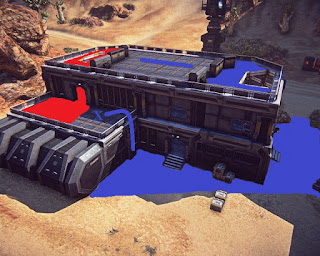Xericor's Tactica:
Lightning Tank (Anti-Infantry)
Hi folks, and thanks
for taking the time to check out my guides.
In this guide I will
look at the role of the Lightning Tank in an anti-infantry set up –
how to use speed and battlefield awareness to get into the best
firing positions as well as what to do to evade vehicles that
outclass you.
The Set Up
This build requires two
main components, the 'L100 Python HE' turret, and 'Night Vision'
optics. The 'Racer High Speed Chassis' also makes for a nice addition
to this build giving the Lightning the speed it needs to escape from
danger.
The Tactic
The Lightning tank uses
its speed to move quickly into a flanking position, or to dart
through gaps in terrain to take enemy infantry by surprise.
The Flank Manoeuvre
In every major
engagement it is vital to understand the position of the battle line.
Often this line will be a case of the defender holding an
installation and the attacker moving on the building or buildings. In
which case the flank is either end of the buildings, or as far as the
defender extends.
Where the defender
doesn’t hold a building, and the combat is more open field, then
the two forces will try to use whatever cover they have available,
more often than not this is a large hill or rock formation.
In the example below we
can clearly see where the two effective battle lines are. Our Blue
forces are positioned along the top of a ridge, and while we cannot
see the enemy Red force, we can safely assume that they hold the
position around the large rocky outcrop.
Once we reach our
destination, the majority of the enemy will be unaware of our attack
until it is too late – all their attention will be focussed on the
enemy to their immediate front. The result is free kills!
The Decisive Strike
As we discussed in the
'Flank' section, understanding the battle line is vital to the
success of this tactic. Where an enemy holds a facility, they will
often hold the area in close proximity, and if their numbers allow
it, they will seek to extend their battle line and secure the best
most advantageous firing positions.
Here we can see the
enemy have extended their battle line south of their installation, to
include the rocks immediately below their base, from which they can
step out, let loose rockets at our approaching vehicles, then duck
back in cover.
The choice to engage
here was made AFTER the enemy had fired their rockets and while the
enemy was RELOADING – speed was key, as was 'burst radius'.
Tip - Burst
Radius/Splash Damage
High Explosive shells
explode when they hit anything solid, and anything within a few
metres of the hit will take damage from the explosion. Always try to
aim for targets that are moving against a solid feature, such as a
hill, a tree, or the side of a building so even if you miss the kill
shot you will still damage the enemy and possibly get them on the
next shot, or pick up points for the assist.
As we can see from the
photo below the only kill shot here is a direct hit. The target is
very small and we are moving, this makes it a very hard shot. If our
shot hits blue, then its a clear miss, and if our shot hits grey its
unlikely the target will receive any splash damage as the enemy is
placed the wrong side of the hill.
Evasion Tactics
This tank is built for
speed and anti-infantry duties, and it will have a very rough time
against MBT's or Air units. It is therefore vital we learn the
tactics of evasion, and how to use our speed and manoeuvrability to
best effect.
Evading Air
A common tactic used by
veteran air players is to approach from the rear of their target and
use Rocket Pods on the weak armour. A common response by the vehicle
is to power drive away in a straight line. This is the wrong tactic
to use. An air unit needs to line up the vehicle perfectly and
unleash a barrage of rockets. As the air unit is moving forward, the
pilot doesn’t mind if their target also moves forward, as a good
pilot can keep the angle and speed of their approach in check and
still hit the vehicle as it pulls away.
What we need to do is
'zigzag'. Evade left then centre, then right, then centre.
This breaks the air
units line of attack. Its weapons are fixed forward, it cannot rotate
its cannons like a tank can its turret, it must shift its whole body.
What this means is the pilot must adjust their aim for every shot
they take. The more effort we force, the more chance they will fail.
Evading Armour
The key to evading
enemy heavy tanks lies with two factors – speed and distance, and
we must learn to maximise both of these parameters to make it doubly
hard for the enemy to land a direct shot.
A good tank commander
can easily predict, and compensate, for one aspect. If the target is
moving left to right, then they will place their shots slightly to
the right of the target. Likewise if a target is moving away, placing
a shot ahead of them is the best idea to score a hit.
When evading armour
remember these two factors and take a diagonal path away from the
enemy. Give them both aspects to take into consideration when placing
their shots.
Thanks for reading and
good hunting soldier!































